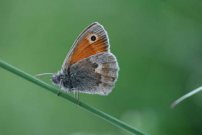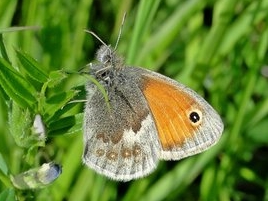
| Butterfly Conservation |
 |
| Hertfordshire & Middlesex Branch |
 |
|
|||
| Saving butterflies, moths and our environment | ||||


Small HeathCoenonympha pamphilusWidespread Distribution and Status The Small Heath was fairly widespread in the two counties in th 1980s and 1990s but by the start of this century many colonies had been lost. Many grassland places like meadows had been left unmanaged giving rise to taller vegetation unsuited to this species. 2017 saw a welcome return for this butterfly and abundance increased further in 2018 with colonies once again found in south Hertfordshire and Middlesex Habitat Requirements Grassland where the sward is kept short and is most common on well-drained soils like chalk downland, heaths and coastal dunes. Smaller colonies can occur in woodland rides, roadside verges, disused quarries, waste ground and even large gardens Larval Foodplants Sheep's Fescue Festuca ovina is probably most frequently used. Bent Agrostis spp, Meadow-grass Poa spp Adult Food Sources Buttercup Ranunculus sp., Cinquefoil Potentilla sp., Devil's-bit Scabious Succisa pratnsis, Common Bird's-foot Trefoil Lotus corniculatus Behaviour/Observation notes Males are very active when patrolling over open grassland around a suitable landmark, like a shrub, in search for females. Mated females will stay in the vicinity of the foodplants and can be approached with ease. The butterfly always basks with its wings closed Life History Two or three generations are produced each year but they often overlap so the butterfly can be seen anytime between May and September. Eggs are laid singly on a grass blade. Larvae spend much of their time at the bottom of a tuft of grass but will feed at night on the grass tips. Larvae will either hibernate or develop to form pupae suspended on a grass stem Further information
UK distribution map |
Copyright Butterfly Conservation © 2019 Hertfordshire & Middlesex Branch
Privacy and Copyright Statement and Cookie Policy Statement
Butterfly Conservation
Company limited by guarantee, registered in England (2206468)
Registered Office: Manor Yard, East Lulworth, Wareham, Dorset, BH20 5QP. Tel: 01929 400 209
Charity registered in England & Wales (254937) and in Scotland (SCO39268). VAT No. GB 991 2771 89